How to Grow Garlic in Containers for Beginners
Wish you could grow a patch of amazing garlic right outside your back door? Now you can! This article will walk you through How to Grow Garlic in Containers so you can do just that.
Gardening 101 is finding a way to grow what you love in a way that works for you can enjoy your own fresh garlic all year long!
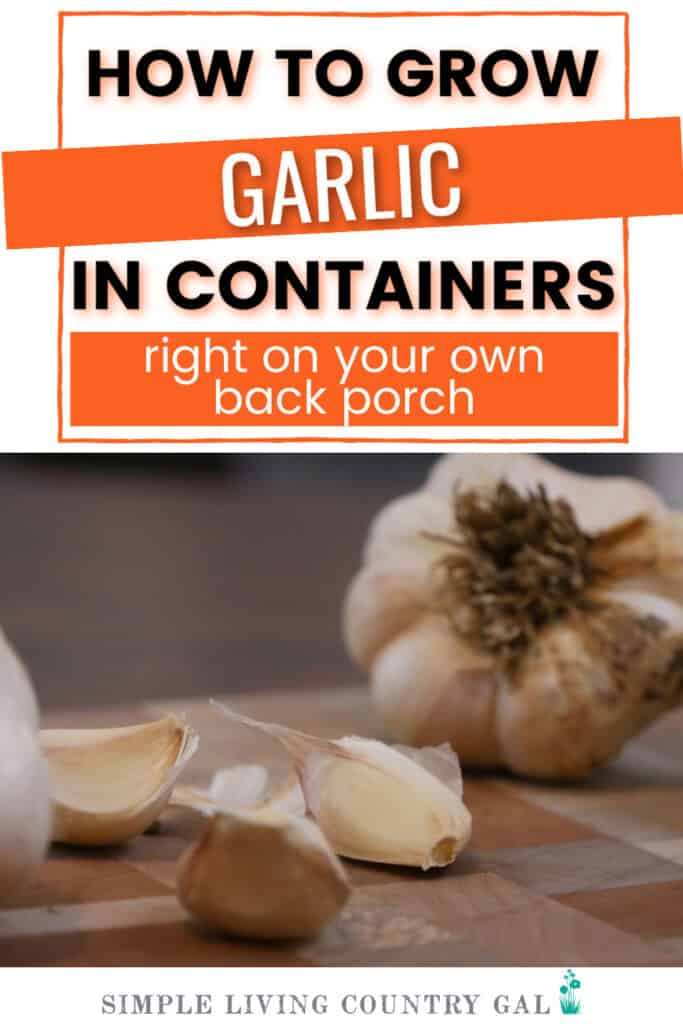
When growing garlic in containers, you can expect a little bit of a challenge.
Garlic has a long growing season and needs regular watering, so you’ll need to give it a good amount of attention for a little longer than the rest of your garden. But even though it needs more attention, I still feel it’s worth it.
Just as with many vegetables and herbs from your garden, the taste is much more vibrant and incredibly enjoyable when fresh.
Growing your own garlic also allows you to grow hard-to-find, unique, and fun varieties.
When it comes to garlic, there are two main varieties of garlic to be aware of: hardneck and softneck. The hardneck varieties prefer cold climates, while the softneck varieties do better in mild climates.
One of the most unique aspects of growing garlic is that you plant your cloves in the fall and allow them to rest over winter, leaving harvest until the following summer. Because of this, growing in containers can be a bit tricky.
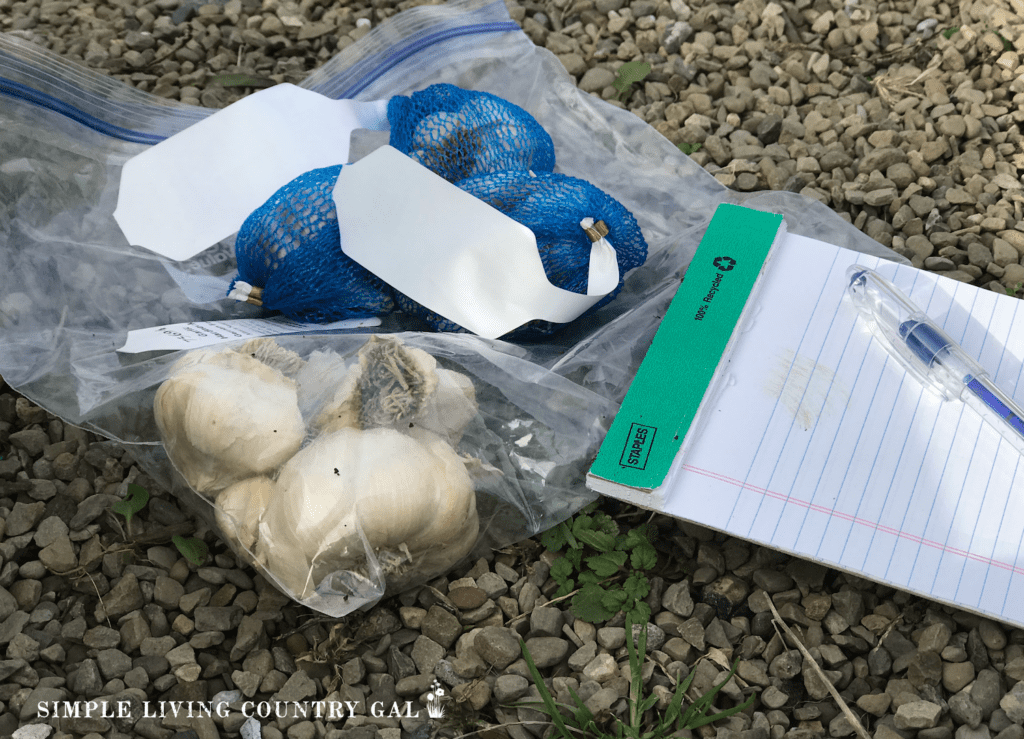
To help, you will need the soil in your container to be able to maintain moisture through that time with regular watering. You can ease the problem slightly by planting in large pots with a lot of soil. The more soil, the more moisture it will maintain.
Garlic should be planted in containers at the same time you would normally plant it in the ground in the fall after the first frost. The ground should be cooled but not yet frozen. Depending on your climate, you should be able to plant anytime between September and November.
The best part of growing garlic is how easy it is to plant. You’ll start your garlic plants with garlic bulbs choosing the variety you prefer.
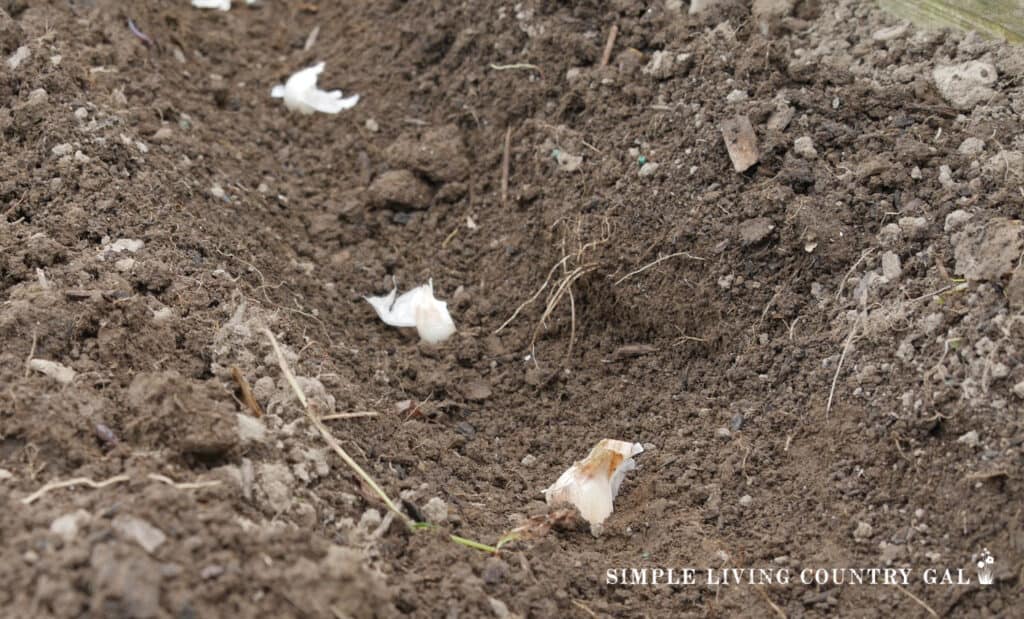
Be sure to purchase your planting cloves from a farmer’s market, nursery, local or online supplier, or you can keep your top heads from your most recent harvest. This is what we do as we love to continue our lines yearly.
Another tip is to choose organically grown heads. Do not use cloves found at the grocery store as those have most likely been treated to prevent sprouting, meaning they are less likely to sprout when planted.
What You Need to Grow Garlic in Containers
Just because I said growing in containers is tricky does not mean it’s impossible. I still believe the extra care needed will make it worth it and especially helpful if you do not have a full garden to plan in.
This means if you live in the city and only have access to a balcony, you can now add garlic to your urban gardening list!
Be sure to grab the FREE Garlic Storage Checklist below!
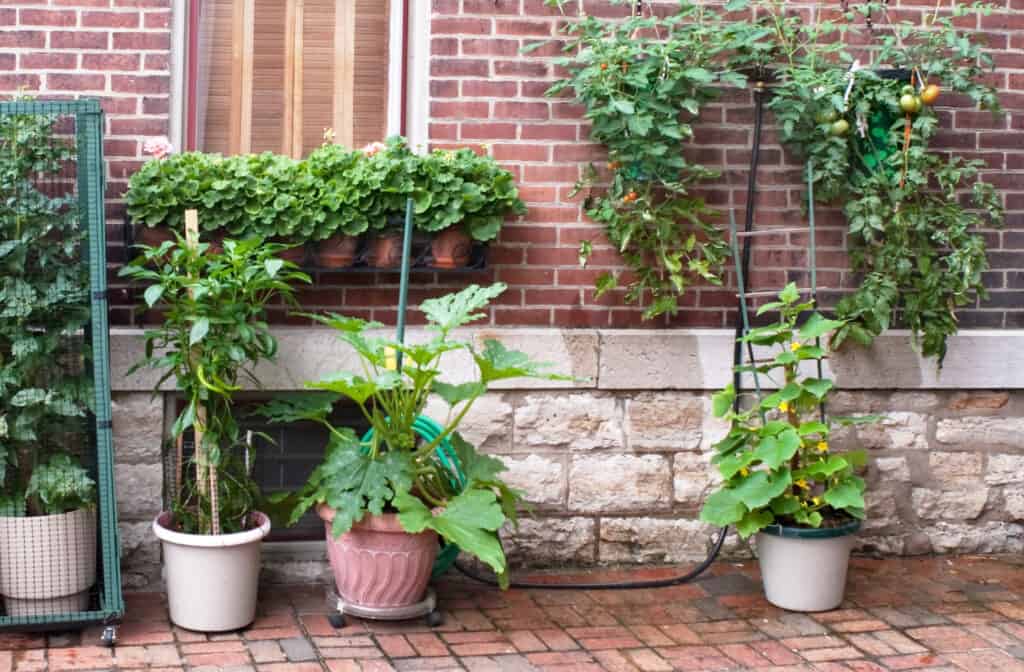
When you’re ready to plant, here’s what you’ll need:
- A large planting container with good drainage
- Some high-quality potting mix
- A handheld garden trowel
- A watering can
- Some firm, healthy cloves, softneck garlic, and/or hardneck garlic
- A container of slow-release fertilizer
How to Grow Garlic in Containers
Once you’ve gathered your supplies, you’re ready to plant.
The first thing you want to do is to choose the best location for your planters. Aim for a spot that gets 6 to 8 hours of sunlight daily. The good thing about planting in containers is if you don’t find the right spot at first, it’s easy to move your containers later to a better spot.
SLCG PRO TIP: Since planters that are full of dirt can be quite heavy, you may want to invest in a few rolling platforms. I have a pretty bad back, and the dollies work great for moving heavy planters on my back patio. Just be sure you get the correct size and ones that can withstand the outdoor weather.
The best time for planting garlic is in the fall, after the first frost. You want the ground to be cool but not yet frozen.
Garlic grows best when it is allowed to establish its roots and then rest (or hibernate) over the winter in the cool soil. If you live in a warmer climate, you can plant your garlic in the spring, but I find the over-wintering really does produce a superior product in the end.
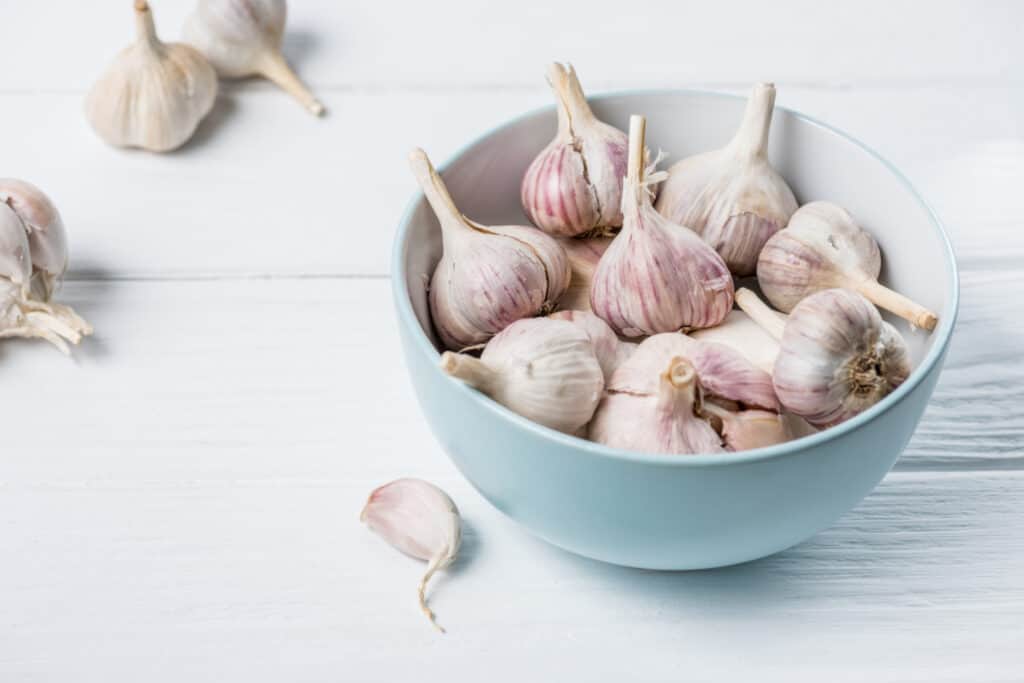
How to Plant Garlic
Fill your container with potting mix to about 3 inches from the top. Check to see if your potting mix contains a slow-release fertilizer. If it does, there is no need to add one. But if it doesn’t, you’ll need to mix one in to ensure your soil is ready and optimal.
Next, gently separate the cloves from a head of garlic. Place the clove in the soil, about 3 inches apart, with the pointy end facing up. Then place more soil over the cloves. If you live in a warm climate area, you’ll need about an inch of soil on top. If your climate is colder, plan on about 2 inches of soil on top.
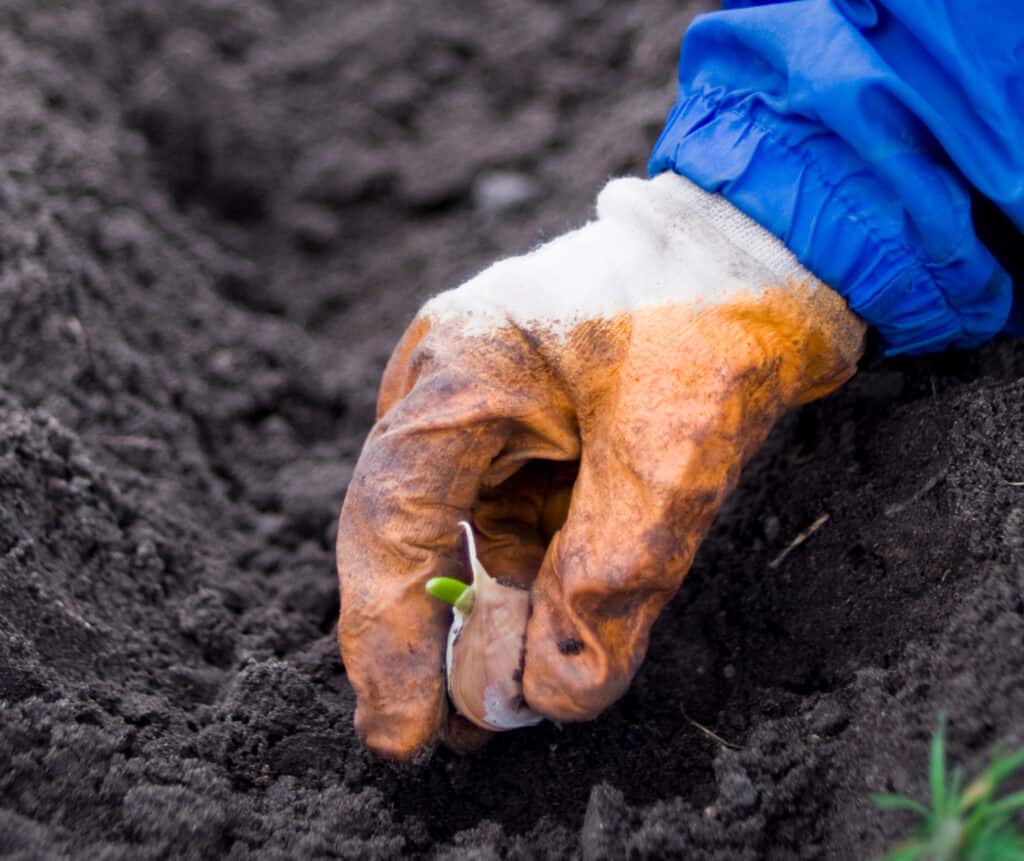
Gently pat the soil down the soil to make the top firm, and place your container in a sunny area. Give your cloves a good watering; you want the soil to be moist but not soggy.
I like to add a layer of mulch, such as straw or dried leaves. This just adds a good layer of protection, especially if you live in a very cold area.
Once the garlic starts to sprout in the spring, fertilize it every few weeks. Water regularly, keeping the soil moist but never soggy.
How Many Plants to Plant
How many plants you decide to plant will depend on how much you use garlic when you are cooking. On average, you should plan for 15 plants per person in your household. Remember that one clove will grow into one plant, giving you a full head of 5-15 cloves to use.
Usually, a pot or two starting out is a good supply of garlic to not only cook with but enough seed garlic to use the following planting year.
How Long Does Garlic Take to Grow?
When growing garlic from a garlic clove, you can expect it to take 8 to 9 months to fully mature and be ready to harvest.
Temperature
Hardneck garlic varieties need 6 to 8 weeks of temperatures below 45° for them to sprout and mature the following season nicely. If you live in an area with warmer temperatures, you can either grow softneck garlic varieties or you can “fake” them out by placing the cloves in the refrigerator for several weeks before planting.
If you choose this method, place the cloves in a plastic bag and poke vent holes in it. Check the cloves regularly for moisture or mold. When they start to sprout, plant them.
Sunlight
Garlic thrives in full sun, at least 6 to 8 hours a day. But, when planted in containers, it’s easier to move the garlic around if need be to follow the sun or to find more of it on a cloudy day.
You do not need to worry about the sun during hibernation, but rather once the plants break through the ground come spring.
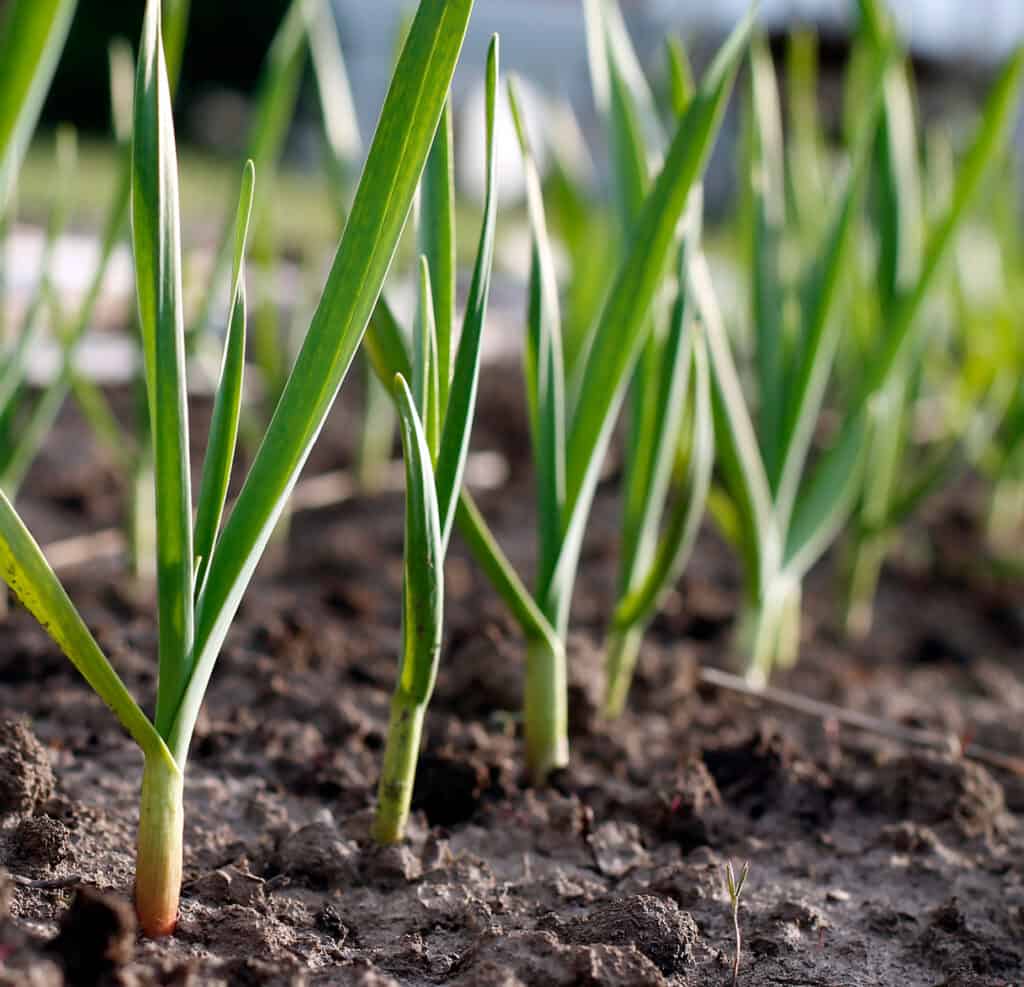
Soil
Loose soil is best for growing garlic and should contain a slow-release fertilizer. If your potting soil doesn’t contain slow-release fertilizer, you can mix some into your soil before planting. The soil also needs to be well-draining so the cloves don’t rot. A good soil option is high-quality potting soil mixed with compost at a ratio of 75:25.
Water
Garlic needs regular watering, about ½ to 1 inch per week, more when the weather is warm and a little less in cold weather when it’s first sprouting. Keep the soil moist but never soggy.
I like to poke my finger into the ground and test the moisture that way. You are aiming for damp but never ever sopping wet. Cloves can rot if kept in overly wet soil, so remember consistency is the key to healthy cloves.
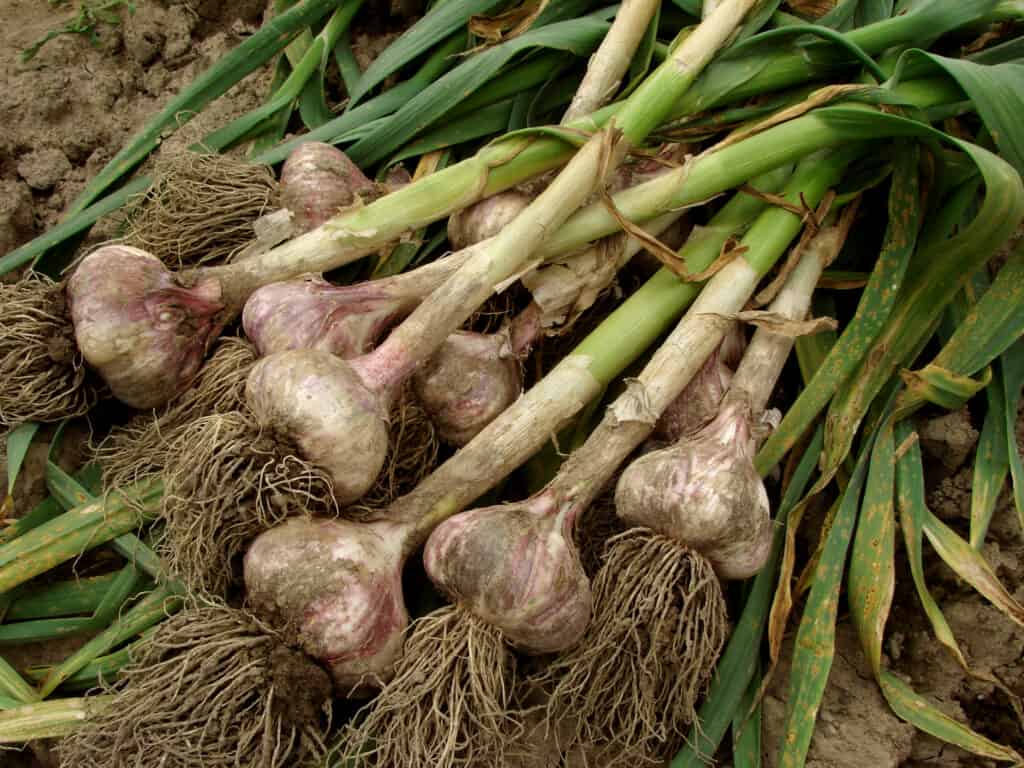
Fertilizing
Garlic is a bulb plant and will need a good amount of phosphorus. Mix 2 to 3 tablespoons of granular organic fertilizer into the soil. Choose one that’s formulated specifically for bulb plants. Use your trowel to mix it in and ensure it’s evenly distributed.
SLCG PRO TIP: Remember, not all fertilizers will work for all gardeners. You need to know where your soil is now so you can best prepare it for the plants you hope to grow in that space. This is true for garden plots in a backyard and containers on a patio or window sill. You can use a pH tester or take a sample of your soil to your local extension office for a more thorough test.
Spacing
Cloves should be spaced about 3 inches apart when planted in the fall. If you’re planting in the spring, they won’t fully mature, so they need less space, about 2 inches apart. See the notes below on spring planting.
In containers, it is best to plant just one clove per container to be sure you have plenty of room for the plant to grow.
Depth
Bury your cloves about 1 to 1 ½ inches deep if you live in a warmer climate. If you live in a colder climate, you’ll want to place your cloves about 2 to 2 ½ inches below the top of the soil.
For this reason, you will want to choose a container that will give your cloves plenty of room for the roots to grow healthy. Try a 5-gallon up to a 10-gallon pot and see how they do.
Spring Panting
While garlic is best planted in the fall, spring planting is possible. There are two main reasons for planting in the fall.
- First, cloves need cold weather to trigger the bulb’s development.
- Second, planting in the fall gives the cloves time for roots to set before the winter. But if you missed fall planting, it’s still possible to get a good harvest by planting in the spring.
Spring planting allows you to either grow to produce bulbs or grow a crop of green garlic, the equivalent of scallions. The plants will form thin stalks with green leaves and small bulbs. You can enjoy the whole plant; they’re perfect in salads, pasta, and sauteed vegetables.
To plant green garlic, press the garlic cloves into your containers in early spring, spacing them closely, about 2 to 3 inches apart. You can harvest the plants when they are 12 to 18 inches tall.
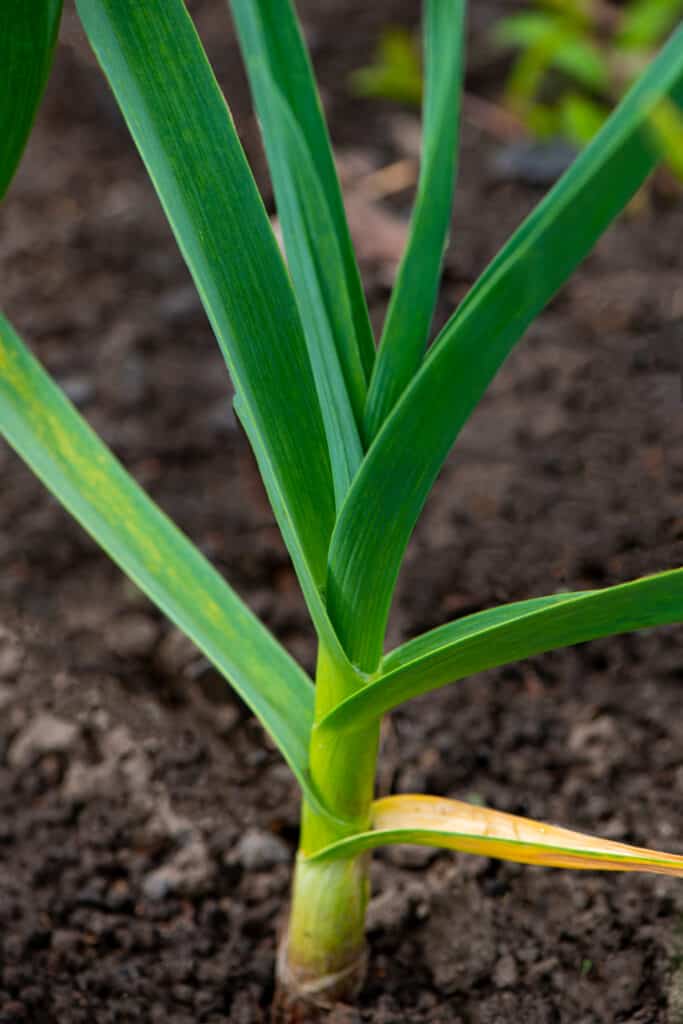
If you prefer to grow full-sized bulbs from a spring planting, you’ll need to provide cooler temperatures for the cloves.
Start by placing cloves in a plastic storage bag and putting them in your refrigerator for 4 to 8 weeks. Poke a few holes in the bag for ventilation. Check on it regularly to ensure you don’t have moisture build-up or mold. When you see sprouting or roots forming, it’s time to plant.
Plant as early as possible. If there is a late winter thaw or a very early spring, it’s time to plant.
Growing Tips for Garlic in Containers
Garlic Tip #1.
After planting, water the soil, then place 1 to 2 inches of mulch or straw on top of the pot. This will help to insulate the bulbs through the winter.
Garlic Tip #2.
If you live in a warmer climate, you can leave the containers in a sunny spot all winter. But if you live in a colder climate, you’ll want to shelter the pot when winter comes. Move it next to your house to provide more insulation, and place leaves or straw around the pot, not on top. You can also wrap the pots in bubble wrap to provide more insulation.
Garlic Tip #3.
When spring arrives, you can move the containers back to a sunny spot and continue watering as normal.
Garlic Tip #4.
Add another 2 to 3 tablespoons of granular organic bulb fertilizer to the soil in the spring by placing it on the soil’s surface.
Garlic Tip #5.
Plants will start to sprout and grow scapes (stalks). To encourage a bigger bulb, break off the scape to divert the nutrients to the bulb. Then, let the plants grow until the foliage is at least 50% yellow.
How to Harvest Garlic
Garlic leaves will start to turn yellow in early summer. Once they’re about half yellow, dump the container and dig out your garlic bulb.
Since the soil has had the winter to compact down, you may find the ground a bit difficult to work through. Use a trowel, being careful not to cut or slice the bulb as you dig.
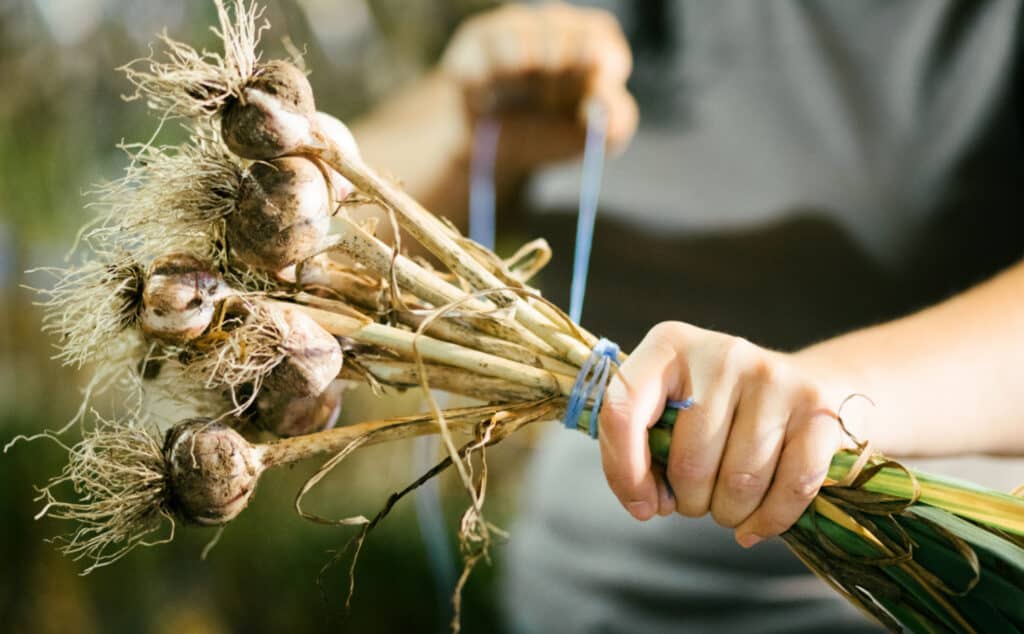
How to Store Garlic
A broken garlic head will generally last about 10 days. Store the garlic at room temperature in mesh bags in a dry, dark place. The ideal temperature for storing garlic is about 60°-65°.
A whole garlic head should be stored the same way but will last for a few months. You can also dehydrate your garlic for dried garlic that will last up to a year at room temperature in an airtight container.
What Diseases and Pests to Watch For
There are a few issues you should watch out for, although growing your garlic in containers instead of the ground will help keep pests and diseases at bay.
White Rot
This is a fungal disease that can attack and cause the leaves to turn yellow, die back, and wilt. The roots can also rot, causing the plants to be uprooted. You can prevent these issues by using a potting soil mix instead of ground soil, keeping the soil moist but not soggy, and removing any diseased plants so they don’t infect others.
Thrips
Thrips are a common insect pest to garlic and onions. They get into the leaves, suck the sap, and cause damage that slows the bulb’s growth.
Thrips are mostly a problem in large garlic fields when they come from neighboring weeds. They don’t cause many issues with container growing but keep an eye out for damage to the leaves. If you find them, remove the infected leaves and throw them away; don’t add them to your compost.
Nematodes
These worm-like creatures can sneak into the stems and bulbs, damaging the plants. It will live inside of and reproduce in the plant itself, eating at the stem, leaves, and bulb. It can survive for several years in the soil.
The easiest way to avoid them altogether is to plant with fresh potting soil to ensure they’re not already in the soil.
Garlic is one of the easiest crops for beginner gardeners to grow, especially in containers. There isn’t much to do other than watch the soil’s moisture.
Choose your containers, get fresh potting soil and fertilizer, and buy fresh garlic from your local farmer’s market or feed mill. Plant and allow things to hibernate during the winter cold. Come spring, you will see fresh, vibrant green shoots break through the ground, letting you know fresh and amazing garlic is on its way.
Garlic is one of my favorite things to grow, and I have loads of help if you want to dive in more deeply to growing your own garlic like a pro.
More How to Grow Resources:
- How to Grow Huge Organic Onions
- How to Grow Spinach for Beginners
- How to Grow Chili Peppers for Beginners
